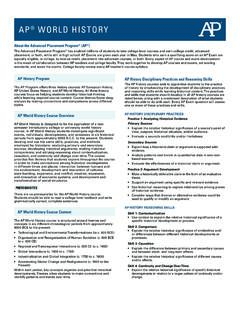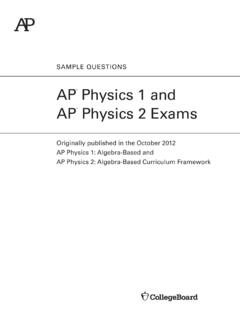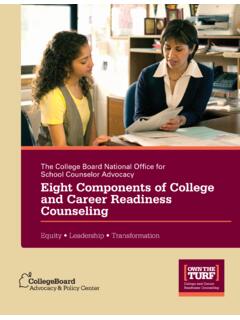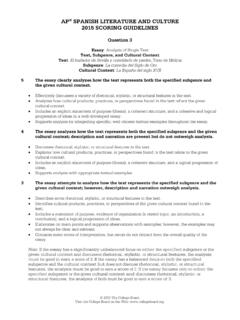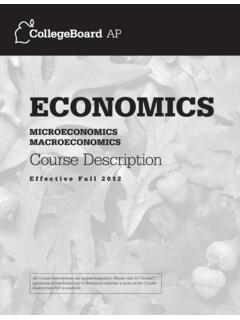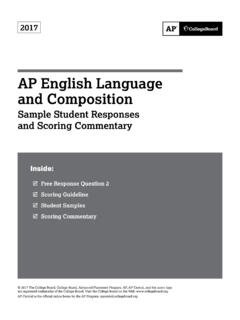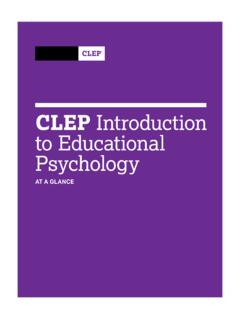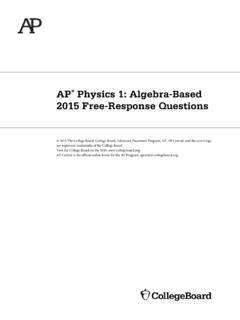Transcription of AP United States History - College Board
1 2017AP United States HistorySample Student Responses and Scoring Commentary 2017 The College Board . College Board , Advanced Placement Program, AP, AP Central, and the acorn logo are registered trademarks of the College Board . Visit the College Board on the Web: Central is the official online home for the AP Program: : RDocument-Based Question RScoring Guideline RStudent Samples RScoring Commentary AP United States History 2017 SCORING GUIDELINES 2017 The College Board . Visit the College Board on the Web: Question 1 Document-Based Question Evaluate the extent of change in ideas about American independence from 1763 to 1783.
2 Maximum Possible Points: 7 Points Rubric Notes A: Thesis and Argument Development (0 2 ) Thesis: Presents a thesis that makes a historically defensible claim and responds to all parts of the question. The thesis must consist of one or more sentences located in one place, either in the introduction or the conclusion. (1 point) Neither the introduction nor the conclusion is necessarily limited to a single paragraph. Acceptable thesis statements must explicitly make a historically defensible, evaluative claim regarding the extent of change in ideas about American independence from 1763 to 1783. Acceptable examples: From 1763 to 1783 colonial ideas about American independence changed from just questioning British policies to calling for revolution.
3 From 1763 to 1783 colonial ideas about American independence did not change much because, throughout the period, many colonists continued to oppose the Patriot cause. Argument Development: Develops and supports a cohesive argument that recognizes and accounts for historical complexity by explicitly illustrating relationships among historical evidence such as contradiction, corroboration, and/or qualification. (1 point) To earn this point responses must explain the relationship of historical evidence to a complex and cohesive argument and do so throughout the essay. Ways that evidence can be related to the argument include the following: Contradiction ( , using evidence to address a counterargument to the main argument in the essay) Corroboration ( , combining multiple pieces of evidence to support a single argument) Qualification ( , using evidence to present an argument that is subsequently made more complex by noting exceptions) B: Document Analysis (0 2 ) Document Analysis (Content): Utilizes the content of at least six of the documents to support the stated thesis or a relevant argument.
4 (1 point) See document summaries for details. Doc 1: Teapot, 1766 1770 Doc 2: Virginia Resolves, 1769 Doc 3: Samuel Adams, Rights of Colonists as Men, 1772 Doc 4: Quaker address to Pennsylvania Assembly, 1775 Doc 5: Janet Schaw, Journal of a Lady of Quality, 1775 Doc 6: Charles Inglis, The Costs of Revolution, 1776 Doc 7: Thomas Paine, American Crisis, 1776 Document Analysis (Sourcing): Explains the significance of the author s point of view, author s purpose, historical context, and/or audience for at least four documents. (1 point) AP United States History 2017 SCORING GUIDELINES 2017 The College Board .
5 Visit the College Board on the Web: Question 1 Document-Based Question (continued) C: Using Evidence Beyond the Documents (0 2) Contextualization: Situates the argument by explaining the broader historical events, developments, or processes immediately relevant to the question. (1 point) The contextualization point is not awarded for merely a phrase or reference, but instead requires an explanation, typically consisting of multiple sentences or a full paragraph. This point can be earned by explaining historical events, developments, or processes that occurred before, during, or after the time frame of the question.
6 Common examples might include the following: Enlightenment ideas Discussion of factors separating Patriots and Loyalists Shifts in British policies and changes in the mercantile system after the end of the French and Indian War (Seven Years War) in 1763 Evidence beyond the Documents: Provides an example or additional piece of specific evidence beyond those found in the documents to support or qualify the argument. (1 point) This example must be different from the evidence used to earn other points on this rubric. This point is not awarded for merely a phrase or reference. Responses need to reference an additional piece of specific evidence and explain how that evidence supports or qualifies the argument.
7 Common examples might include the following, with appropriate elaboration: Articles of Confederation (1781) boston massacre (1770) boston Tea Party (1773) Boycotts / nonimportation movements Committees of correspondence Declaration of Independence (1776) Benjamin Franklin Alexander Hamilton Thomas Jefferson George Washington D: Synthesis (0 1 ) Synthesis: Extends the argument by explaining the connection between the argument and either a development in a different historical period or geographical area and/or a course theme and/or approach that is not the focus of the essay. (1 point) The synthesis point is not awarded for merely a phrase or reference.
8 Common examples might include the following, with appropriate explanation: Different period or area: French Revolution; Haitian Revolution; United States Civil War Different theme: economic History If response is completely blank, enter - - for all four score categories A, B, C, and D. AP United States History 2017 SCORING GUIDELINES 2017 The College Board . Visit the College Board on the Web: Question 1 Document-Based Question (continued) Document Summaries Document Content Explains the significance of point of view, purpose, context, and/or audience by elaborating on examples such as the following: 1.
9 Teapot, 1766 1770 Inscribed on one side is No Stamp Act, and on the other is America, Liberty Restored. Importance of growing American trade and commerce with Britain (context) British manufacturers capitalized on/profited from Stamp Act crisis (purpose) Consumers in Britain and colonies (audience) 2. Virginia Resolves, 1769 Declares autonomy of the Virginia legislature, together with loyalty to the British crown. Concepts in the resolves spread to other colonies, which adopted similar resolutions; longstanding autonomy of colonial legislatures (context) Other British North American colonial assemblies; the British Crown and Parliament ( audience) 3.
10 Samuel Adams, Rights of Colonists as Men, 1772 Declares the sovereignty of man over governments. Law of nature supersedes any manmade laws. Political leader, Patriot, member of Sons of Liberty (point of view) Apply Enlightenment ideas to support the growing calls for colonial independence (purpose) The growth in the trans-Atlantic exchange of concepts of republicanism ( context) 4. Quaker address to Pennsylvania Assembly, 1775 Quaker leaders encouraged other Quakers not to join agitation against the British government. Divine Right of Kings. Pacifism among some Quakers (context) Apply pacifist principles to revolutionary situation; prevent war with and declaration of full independence from Britain (purpose) 5.
